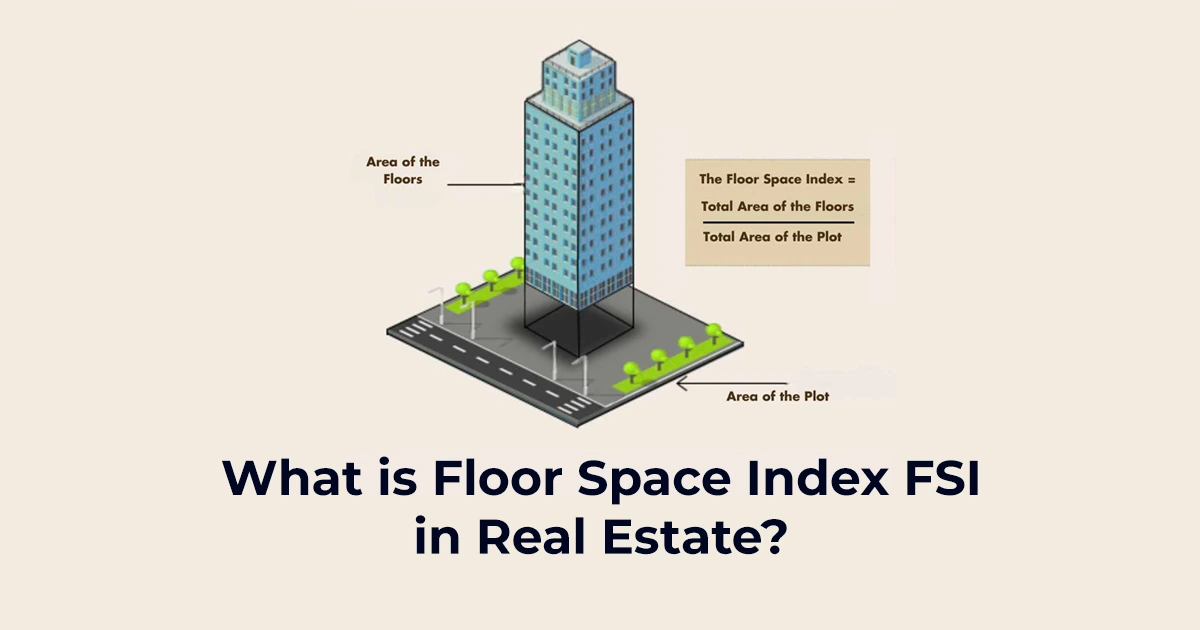A city grows on careful density; FSI in real estate, depends on good infrastructure and planned expansion. Its macroeconomics actually have a tangible result in real estate by way of the Floor Space Index (FSI).
By defining the admissible built-up area on any plot, FSI directly affects property valuation, resale possibilities, and even the livability of neighbourhoods.
Therefore, an understanding of FSI in real estate is fundamental for landlords desiring to shape a skyline, buyers, and investors wishing to factor spatial opportunities into wiser investment decisions.
See also: IOD Full Form in Real Estate: Process & Documents Guide
Historical Background of FSI in real estate
Understanding the history of FSI will lead buyers and investors to appreciate its role in urban planning. FSI, now referred to as FAR- Floor Area Ratio-originally introduced in India as an instrument for regulating urban density, infrastructure load, and population growth, has been instrumental in managing these factors for ever-developing cities.
Previously unrestricted construction usually resulted in streets overcrowded with pedestrians, inadequate ventilation, and overstretched civic amenities, prompting authorities to consider adopting FSI-based planning.
What Is FSI in Real Estate?
FSI in real estate, or floor space index, is the ratio of the total built-up area of a building to the plot area. In other words, it indicates the maximum floor area that can be constructed on a parcel of land by a developer or an owner.
On the other hand, the Floor Space Index is defined as the extent of construction that can be done on a plot as regulated by the municipal authorities or the DCR (development control regulations). FSI is an important parameter in the planning of cities and towns, as it allows orderly and planned construction, thus preventing overcrowding and ensuring that adequate light, ventilation, and infrastructure support are provided to residential and commercial sectors.
Floor Space Index Formula
- The FSI calculation is fairly simple; it basically has two inputs: the total built-up area and plot area of a given building. The formula for FSI is:
- FSI=Total Built-Up Area of the Building/Area of the Plot
Example:
- Plot area: 2,000 sq. ft.
- Total built-up area: 4,000 sq. ft.
- FSI=4,000/ 2,000=2
Hence, the Builder can build up to twice the area of the plot.
Significance of FSI in Real Estate
FSI has an important role in development planning and investment decisions in real estate. Here is why:
Construction Capability Determiner
FSI restricts construction in a parcel in a given area. High FSI will permit the builder to put up many more stories or more over-building; a low FSI would restrict a lower number of stories to be in line with the original density of a locality.
Foremost Influence on Property Valuation
Properties in areas with high permissible FSI almost always draw a premium value; the reason being, more numbers of units or bigger-sized luxury apartments can be accommodated in them, leading to much better returns from an investment. Areas with low FSI limit other construction options, affecting property rates in demand.
Controls Density in Urban Areas
With FSI control, municipalities curb population density, traffic, and infrastructure load. This means that in areas where FSI is high, the infrastructure must necessarily be good, while that of low FSI shall maintain open spaces, greenery, and environmental quality for the neighbourhoods
Aids Homebuyers and Investors
For a homebuyer, understanding F.S.I. helps in the selection of properties pertaining to the most efficient use of space and future appreciation potential. On the other hand, for an investor, F.S.I. provides insight into another determinant of returns, that of resale value and development.
How is FSI applied in different cities?
FSI regulations in India are differentiated at a municipal level, and the permissible FSI is defined by these authorities depending on the level of urbanization, the infrastructure level, and zoning regulations. Here is how the FSIs are for residential and commercial properties across the cities:
| City | Residential FSI (Typical) | Commercial FSI (Typical) | Notes |
| Bangalore | 1.5 – 2.75 | 2.5 – 4 | Varies by locality and plot size |
| Chennai | 1.5 – 2 | 2 – 3 (approx., varies by building type) | Depends on the zone |
| Delhi | 1.2 – 3.5 | Up to 4 for redevelopment | Higher FSI for redevelopment projects |
| Gurgaon | 1 – 1.45 | 1.5 – 2 (approx.) | Most sectors have low FSI |
| Ahmedabad | 1.2 (central areas) | Up to 1.8 (outskirts) | Limits vary by location |
| Pune | 1.5 – 2.5 | Up to 5.5 (slum redevelopment) | FSI incentives for redevelopment projects |
| Mumbai | 1.33 (Island City) | 0.5 – 1 (suburbs), 2.5 (MHADA projects) | High FSI in special projects |
| Hyderabad | No fixed cap | May go up to 6 – 7 | Depends on infrastructure and plot size |
| Kolkata | 1.5 – 2.5 | 2 – 3 (approx.) | Varies by locality |
Through this data, the investor and home buyer will understand the possible FSI impacts locality-wise in terms of construction potential, as well as space utilization and returns on luxury property.
FSI Incentives and Premium FSI
On occasion, municipal authorities allow exceeding the standard limit of FSI under a few conditions:
- Premium FSI—Fast-moving developers can acquire FSI beyond the basic limit by making extra payments to the municipal corporation.
- Incentive FSI—They are awarded to some cities for granting bonus FSI towards the provision of green spaces, affordable housing, or better public amenities.
These benefits can be useful for buyers to judge the authenticity of Premium projects in India.
Factors Affecting FSI in real estate
FSI in real estate is decided based on several factors in any city or locality:
- Zoning Regulation: Different zones, such as residential, commercial, and mixed-use, have different permissible FSI limits.
- Plot Size: Large plots may sometimes have a higher permissible FSI.
- Infrastructure Availability: Areas provided with good roads and water, and sewage systems may support a higher FSI.
- Development Control Regulations: Local municipal laws and state policies define maximum FSI limits for various regions.
- Amenities: Provision for open space, parking, and green areas may affect FSI calculations.
Types of FSI in real estate
FSI can usually be classified according to the application of the concept in the following manner:
- Basic FSI: Standard FSI as provided by law without any incentive metrics.
- Premium FSI: Further permitted for purchase by the developer in a higher price range, by and large in commercial properties.
Effective FSI: Practical FSI, i.e., Base FSI plus premium projects being considered.
Advantages of Understanding FSI for Buyers
Optimal Space Utilization
Knowing the FSI empowers homebuyers to assess from the standpoint of the expected built-up space per unit. This thereby enables efficient planning for living spaces, amenities, and parking.
An Edge in Investment
The direct cause-and-effect relationship between FSI and value and appreciation of a property presents a buyer with greater possibilities in an FSI area with good commercial viability. Rental income and capital gains prove to be better in high FSI areas since more usable space can be created on the same plot.
A Comparative Building Project Analysis
Investors get to compare real estate investments based on FSI so they can select for spacious living apartments or for developments that promise better returns. For example, an FSI in real estate of 3 typically allows larger apartments or more floors than an FSI of 1.5.
With Better Choices on Multi-storey Buildings
For those buyers contemplating apartment or multistorey flats, FSI works on the density and privacy issues with a building. The greater the FSI, the more likely the buildings will be higher, with common areas probably getting more crowded.
FSI and Real Estate Returns
FSI in real estate is not only a parameter for zoning alone but also has direct implications in monetary terms.
- High FSI and High Returns: Major metropolitan cities with high-density projects never fail to generate higher saleable areas in return.
- Retain Resale Value: Properties built under high FSI normally enjoy good value appreciation within gradually shorter periods, being located in commercial hubs or well-connected residential localities.
- Rental Yield: It actually offers the developer the possibility of increasing the number of units for renting—it maximizes rental income for the investor.
See also: What is Stilt Parking: Meaning, Stilt Area & Floor Plan
Practical Tips for Homebuyers

- Check if FSI is permissible: Check with the municipal authorities about the specific FSI allowed on your chosen plot or project.
- Calculate built-up area: Estimate the construction allowable by multiplying the area of the plot by the FSI.
- Check for amenities and density: Increased FSIs might mean less open space, parking, and privacy.
- Consider Investment Potential: FSI has such appreciating value in property, but it can also make your wallet suffer heavily in the long run.
- Consult with Experts: Prior to making the purchase, one such perspective worth considering would be that of real estate agents/legal advisors regarding the implications of FSI.
Conclusion: FSI in Real Estate
Floor Space Index (FSI), perhaps more than any other aspect of real estate, really makes or breaks construction potential, investment returns, and urban planning. Clearly grasping what FSI means in real estate—his formula and actual application—will provide necessary guidance to homebuyers and investors to make wise choices.
In high FSI, more property uses tend to increase, along with resale value and investment potential beyond municipal regulations and developmental goals in the context of growth.
FSI should always be checked out from the respective municipal authorities or builders before stepping into real estate. This way, the investment bank that has been made is safe, but much more importantly, the act ensures compliance.
FAQ’s
High FSI areas are typically located in metropolitan or well-developed urban zones. Cities like Mumbai, Bengaluru, Pune, and the Delhi NCR region feature zones with higher permissible FSI, leading to more spacious apartments and better returns. Checking municipal zoning maps can provide detailed FSI information locality-wise.
FSI determines the ratio of the total built-up area to the plot area. A higher FSI allows developers to construct more floors or units, increasing potential rental income and resale value. Conversely, lower FSI restricts construction but may maintain exclusivity and open space, impacting long-term appreciation differently.
Understanding FSI helps homebuyers compare projects effectively, estimate usable space, and choose homes that balance floor area, privacy, and investment potential. It helps in identifying well-planned developments over overcrowded or poorly designed projects.
FSI directly influences the height, density, and scale of multi-storey buildings. A higher FSI allows for taller buildings and more units, impacting the overall living experience, infrastructure demand, and property value within the project and surrounding locality.




Comments are closed